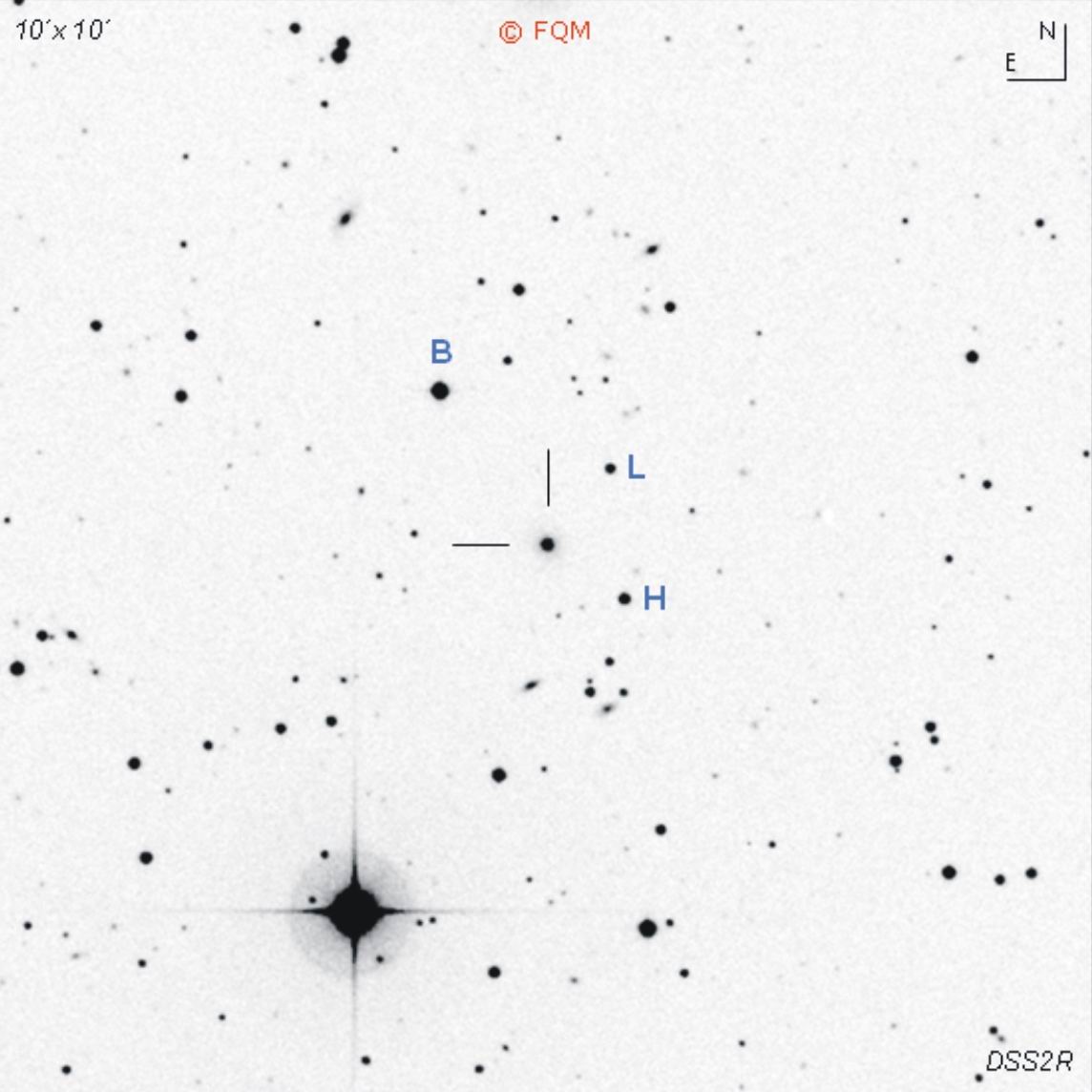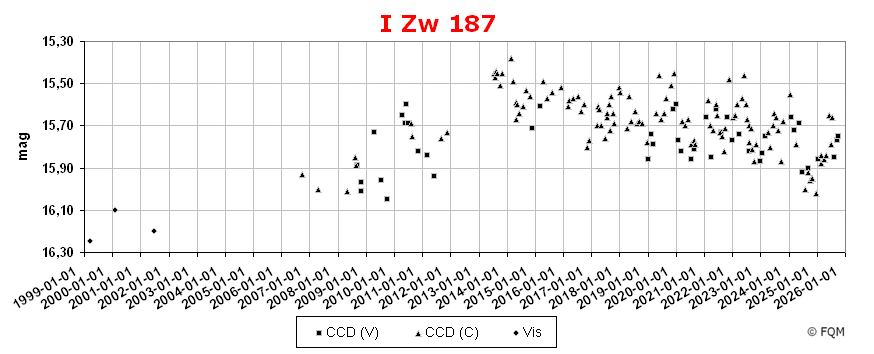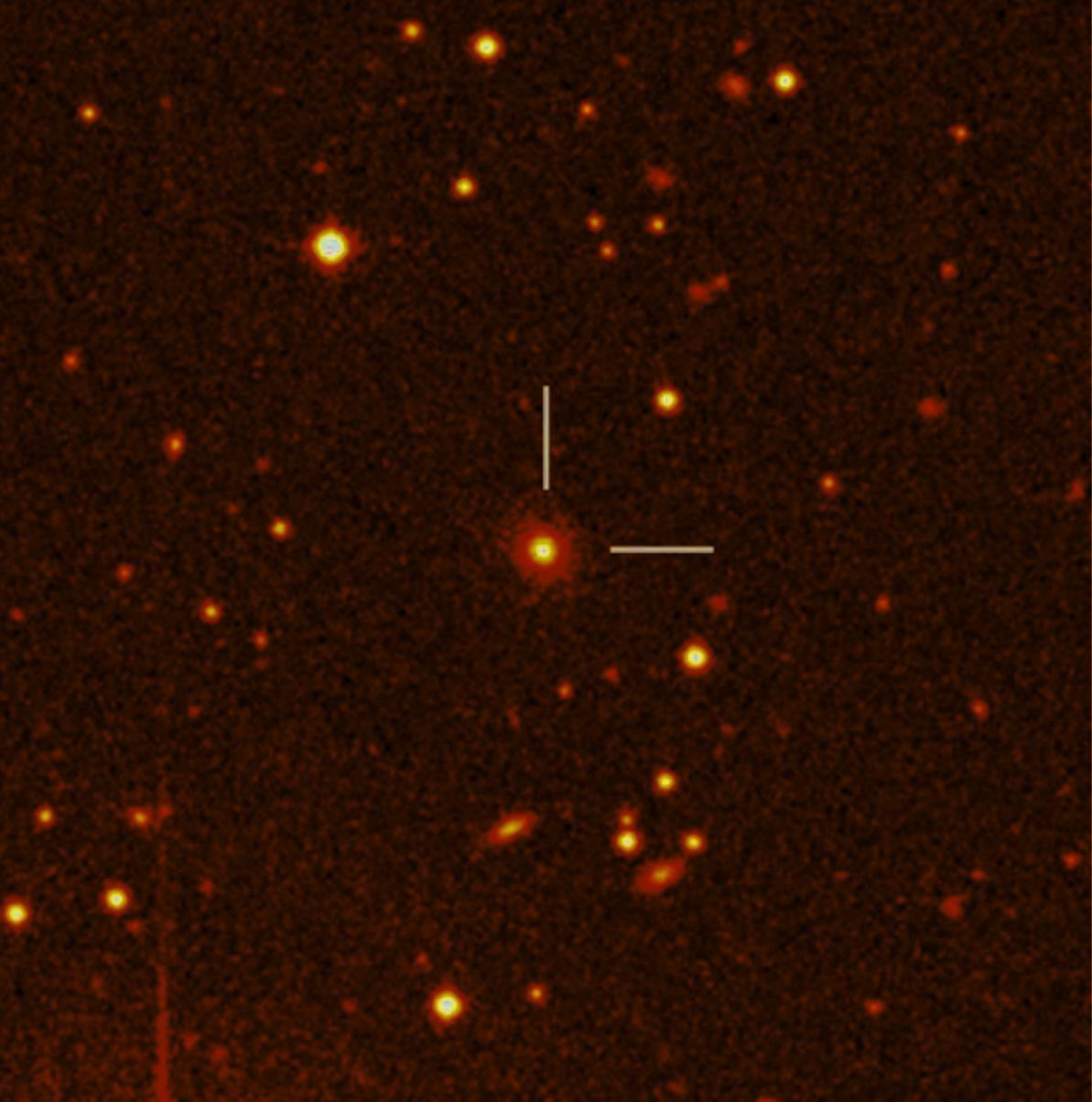
| Frankfurt Quasar Monitoring |
| I Zw 187 = OT 546 |
| Cross-Identifications | OT+546, OT 546, II Zw 77, PGC 60348, 1727+502 87GB 172704.2+501535, 2MASXi J1728186+501310 TXS 1727+502, MG4 J172809+5013, PKS 1727+502 RGB J1728+502, 1ES 1727+502, 1H 1730+500 RX J172819.1+501309, 1AXG J172815+5013 XSS J17272+5025, 1FGL J1727.9+5010 |
| Equat. coordinates | RA 17 28 18.6 DE +50 13 11 (J2000) |
| Constellation | Hercules |
| Type | BL Lac |
|
Redshift |
z=0.055 |
|
Distance (2) (3) |
224 Mpc |
| Total mag range (mv) (4) | 14.2 - 16.8 |
| Catalog Magnitude (1) | 15.97 |
| Absolute Magnitude (1) | -21.1 MB |
| Light Travel-Time (2) | 0.712 × 109 yrs |

Comparison stars
| star | V | Rc | Ic |
| B | 13.14 (0.06) | 12.81
(0.06) |
12.49
(0.06) |
| H | 15.29
(0.06) |
14.99
(0.06) |
14.66
(0.06) |
| L | 16.10
(0.09) |
15.71
(0.09) |
15.35
(0.08) |


| I Zw 187 =
OT 546 is
a
variable BL Lac object in northern Hercules, very close to the
constellation Draco. The designation I Zw 187 refers to swiss-born
astronomer
Fritz
Zwicky (Zw), who first recognized this 16.1-mag object as a compact
galaxy ("Fuzzy red variable
spherical compact."). He published his find in his first catalog
(1964). His initial spectral analysis showed a featureless blue
continuum. In the
late 1970s, the first redshift was measured. Consequently, I Zw 187 was
classified as a BL Lac object, as this object shows both optical
polarization and an optical variability by
about 2.4 magnitudes. Around the year 1967, this object was first
discovered as a strong radio
source during the Ohio State University Radio Survey (OT). Later on, it
has been cataloged by various
other radio surveys. Radio interferometry
revealed a complex jet extending towards the
northwest. Furthermore, I Zw 187 was recognized as an X-ray source by ROSAT in
the
early 1990s. I
Zw 187 can be described as an X-ray selected BL Lac object and a flat
spectrum radio source. The BL Lac object resides in an elliptical
galaxy with an
apparent diameter of 0.28´× 0.23´, located at a distance
of 237 Mpc. The central supermassive black hole has an estimated total mass of 5.4×108 solar
masses. CCD observers, as well as visual observers, shall use the comparison stars given above. Another photometric sequence was published by Craine et al. (1975). I Zw 187 was mislabeled as I Zw 186 in Craine's Handbook of QSOs. BL Lac object I Zw 187 is located in northern Hercules, very close to the border of Draco. I Zw 187 is easy to locate as its position lies only 2° south of Beta Draconis in the Draco´s head. Visual observers need at least a 14-inch telescope or larger to glimpse this stellar object. Even with large aperture telescopes I:Zw:187 remains stellar. ____________
Two interesting globular clusters are only about 7° away: First to mention is M92, the second brightest globular in Hercules - an easy task for 8-inch telescopes. The second globular is NGC 6229, considered to be about 100 000 light-years distant. The brightest stars of NGC 6229 are only mag 15.5, so you will need at least 12- to 14-inch of aperture to resolve some few and very faint stars of NGC 6229. Observers who search for more quasi-stellar objects, the constellations Draco and Hercules are rich with bright targets. No less than 6 quasars of mag 14 and mag 15 are located within a 10°-radius around I:Zw:187: - IRAS 17500+5046 (3.7° E) -> CDS - HS 1817+5342 (8.4° E) -> CDS - IRAS 17596+4221 (9.8° SE) -> CDS - PG 1718+481 (2.6° SW) - PG 1700+518 (4.5° WNW) - PG 1626+554 (10.4° NW) -> CDS |
| Angel, J.R.P., Stockman, H.S. 1980, ARA&A, 18, 321; Optical and infrared polarization of active extragalactic objects. Akiyama, M., Ueda, Y., et al. 2003, ApJS, 148, 275; Optical Identification of the ASCA Medium Sensitivity Survey in the Northern Sky: Nature of Hard X-Ray-Selected Luminous Active Galactic Nuclei. Craine, E.R.; A Handbook of Quasistellar and BL Lacertae Objects; Parchart Publishing House, Tuscon 1977. Craine, E.R., Johnson, K., Tapia, S. 1975, PASP, 87, 123; UBVr Sequences and Observations of optically identified Radio Sources. Fan, J.H., Lin, R.G. 1999, ApJS, 121, 131; Infrared Variation of Radio-selected BL Lacertae Objects. Fiorucci, M., Tosti, G. 1996, A&AS, 116, 403; VRI photometry of stars in the fields of 12 BL Lacertae objects. Healey, S.E., Romani, R.W., et al. 2007, ApJS, 171, 61; CRATES: An All-Sky Survey of Flat-Spectrum Radio Sources. Kollgaard, R.I., Gabuzda, D.C., Feigelson, E.D. 1996, ApJ, 460, 174; Parsec-Scale Radio Structure of Four X-Ray-selected BL Lacertae Objects. Oke, J.B., Sargent, W.L.W., et al. 1967, ApJ, 150, L173; A variable radio-quiet compact galaxy I Zw 1727+50. Oke, J.B. 1978, ApJ, 219, L97; The redshift and other properties of I ZW 1727+5015. Skrutskie, M.F., Cutri, R.M., et al. 2006, AJ, 131, 1163; The Two Micron All Sky Survey (2MASS). Steinicke, W.; Katalog heller Quasare und BL Lacertae Objekte; Umkirch 1998. Steinicke, W.; Beobachtungsliste für helle Quasare; Umkirch 1999. Steinicke, W. 1999, Interstellarum 15, 42; Unbekannte Quasare für visuelle Beobachter. Véron-Cetty, M.-P., Véron, P. 2001, A&A 374, 92; A Catalogue of Quasars and Active Nuclei: 10th edition. Véron-Cetty, M.-P., Véron, P. 2003, A&A 412, 399; A Catalogue of Quasars and Active Nuclei: 11th edition. Véron-Cetty, M.-P., Véron, P. 2006, A&A 455, 776; A Catalogue of Quasars and Active Nuclei: 12th edition. Véron-Cetty, M.-P., Véron, P. 2010, A&A 518, 10; A Catalogue of Quasars and Active Nuclei: 13th edition. Zwicky, F., Zwicky, M.A.; Catalogue of Selected Compact Galaxies and of Post-Eruptive Galaxies; Zürich 1971. |
| Links: Landessternwarte Heidelberg AAVSO |